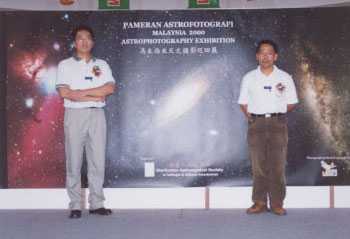| Mr William Yang 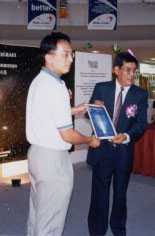
|
Taiwan |
At age 10, he was already trying to
build his own telescope using his grandmother's
reading glasses and taping one of the lenses to a
body tube made from a rolled up newspaper. He
borrowed eyepieces off his school's microscopes. In
school, his favourite art subjects were always of the
stars, planets, anything about the universe,
"..and telescopes. The art teacher found it most
curious that all my works were out of this
world." His first memory of seeing the Milky Way
was during a fishing trip with his Dad. Does his
father know anything about astronomy? I asked.
"He told me to go look up a book." Not long
after, his Dad surprised him with a present : an 80mm
toy telescope. "Probably to stop me from
stealing my grandmother's glasses," he laughed.
His toy scope's first light was the Moon. Quite by
accident, he next aimed his scope at a bright yellow
star which turned out to be Saturn. These remain his
favourite childhood night sky objects. He would spend
every night out after dinner observing till 10pm.
School homework, of course, had to be done in the
afternoon. His first astrophotography attempt was the
Moon at age 14. He recounted amusingly how he had
trained himself to memorize the rate at which his
hand turned the RA and Dec knobs before fixing in the
camera so that he could track the object by heart for
up to one minute. "Not too bad, I probably got 2
out of 36 shots right." He later moved to
America with his family. His toy scope followed him
there. His first astronomy expedition of sorts was
while camping with his family at Yosemite Park.
"That was the first time I stayed up from dusk
to dawn, blown away by the brilliance of stars under
the American sky." The stars he claimed, were
even brighter than those back home in Taiwan.
Throughout that first night, the howls of coyotes
accompanied him, plus there were bears in the
vicinity. "Dangerous, and quite scary too,"
he quipped. His first purchase was an orange
Celestron 80mm f/9 with an equatorial mount when he
was 17.
So concludes my interview with Mr
William Yang. He is quite a remarkable person. I'm
including a small synopsis from his talk "The Fun of
Astronomical Instruments Making". I sat in for this
talk which was conducted in Chinese.
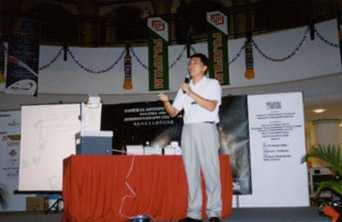
After graduation, he returned to
Taiwan. In 1995, WILLIAM OPTICS was set up with one
focused mission : To make a genuine astronomical
product that would prove to be a strong opponent in
the leagues of America's AstroPhysics and Japan's
Takahashi. He bought the ingredients and figured out
the chemical composition from scratch. He searched
far and wide for the best optical glass available.
Over the years, he has met with many different
setbacks and failures in the quest for the ultimate
scope and is most grateful for the many people who
have assisted him in his foundation research. There
was a 15-minute summary of his experiences which
concluded that German-made glass together with
fluorite coating were the most potent combination at
this point in time. He then launched into a breakdown
of how his apochromatic scope was made and assembled.
Everything, he says, right down to the screws and
bolts of the scope, was redesigned and remade. People
often tell him how silly it was to waste time fussing
over a simple screw, but it was important to him. He
wanted to see to it personally that the entire
conception of the telescope, every part was his and
his alone. The caps are personalised with a swan
logo, the trademark of WILLIAM OPTICS. (He even
experimented with inscribing the logo onto the head
of a screw.) The tube body was a triple-layered
coating to give it the pearly-white exterior that was
scratch- resistant; The retractable dew cap had a
ring coat of 18-carat gold around it. He recalls how
when he first launched his telescope at an American
Star Party, it was critiqued mercilessly. But that
was history and it proved to be the turning point for
WILLIAM OPTICS as he is back with better scopes that
is set to compete on the international market of
astronomical instruments, beside AstroPhysics and
Takahashi.
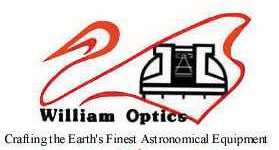
Check out William Yang Optics at http://www.williamoptics.com
Ok, this could possibly be a poor
interpretation by myself of the 90-minute talk. Any
mistakes, misunderstandings or misinterpretations is mine
and mine alone. I remembered being extremely impressed
with his fortitude and strong determination to break the
traditional waves. His enterprising ways at how he
handled assembling a telescope from scratch are nothing
short of extraordinary. Here is one man who spent 3 days
in a row without sleep to design the 142 basic parts to
his equipment. WILLIAM OPTICS is going places. He now has
his own dovetail plates that is touted to fit all
astronomical products from Celestron and Vixen to
Takahashi and AstroPhysics. He had just launched his own
private line of equatorial mounts and GOTO technology. At
this moment, there are plans underway to build the
largest fluorite Apochromat refractor in central Taiwan.
This 9" triplet fluorite APO will be made by
the William Optics. I have every confidence that WILLIAM
OPTICS will be an astronomical force to be reckoned with
in the 21st century. - Lin
|
| Mr Lin Qisheng 
|
Taiwan |
Everything he knows about astronomy
and astrophotography, he learnt on his own when he
was young. He used his school's telescope extensively
throughout his youth. Finally, at age 21, he bought a
100mm f/6 reflector on a Vixen SP. He still remembers
the dates and circumstances when this occurred.
December 6, 2315hrs, his friend came over with the
maps to track Halley's comet. The very next day he
purchased the R100S. He spent the next few months
tracking, observing and photographing the comet. His
first solo astronomical expedition was at age 22. He
bundled up all his equipment and took a bus to Lishan
Tienchi, a 2600-ft high mountain. He forgot his
controller and so had to do manual guiding. Armed
with his first shots, he approached the Japanese
astronomy magazine, Sky Traveller. Six months later,
the magazine published his first astrophotograph.
Henceforth, he became a regular contributor to
astronomy magazines, both locally and overseas. He
sheepishly recounts how he delayed his graduation
from the university just to delay his national army
service, and take more astrophotographs. He bought
the Takahashi MT160 reflector and borrowed the EM100
from a local science magazine. Once a week for 2
hours he would travel 240km from his mountain
hideaway to attend classes at the university. The
rest of the time he spent up in the mountains
perfecting his photography. Thereafter, he spent 2
years serving the nation. Soon after his conscription
ended, he started work and with his savings, placed
an order for the AstroPhysics 130EDT which took
another 2 years to get to him.
Mr Lin Qisheng's memory is amazing. He
remembers many events chronologically right down to the
specific date and even time. I have heard a few stories
about him spending much time alone in the mountains
photographing the skies.
Was he ever afraid?
"Initially, yes. There was no one for miles
around. But I got used to it. So far, I haven't
encountered anything, seen or unseen." Any
interesting tales? "1996, October 10, evening. I
was photographing Hale-Bopp, 1995O1, and 1996Q1. I
thought I'd take a break and I used the AP130 box to
sleep in which looked pretty much like a paper
coffin. The police came. They thought I was dead or
something. I got off with a warning to use the
triangular breakdown plate that cars use, just in
case, I might get run over by a car while
sleeping." His most adventurous trip to date?
"I was with another astrophotographer, Anthony
Chong. We took a single 150cc motorbike up to Xiao
Xueshan (Little Snow Mountain) a 2600m high mountain.
Two of us rode some 275km to the mountains carrying
with us the AP 130EDT, EM200, SP, food, clothes, 13kg
battery, and all other essential equipment. I think
that journey was the ultimate trip. I don't think
Anthony will be making another trip like that one
anytime soon," he grinned. He remembered another
time April 18, 1999 at Yu San National Park. It
turned cloudy halfway through the night. He decided
to take a walk when he spotted another pair of
astronomers. As he approached them, he overheard them
talking about him. "It's incredible, this gossip
about me that was going around. Rumours were flying
that I switched 24 jobs in one year."
His latest trip was to Australia where
he photographed many more stars in the desert. "It
was a different experience altogether. It was like going
back to ground zero. I couldn't recognize a lot of the
southern constellations. I was re-learning the night sky
all over again." For this trip to Kuala Lumpur, he
brought some 63kg worth of books and magazines to donate
to the astronomical societies. There was the entire range
of astronomical magazines which have featured his
photographs. To date, he has taken over 3000 astrophotographs.
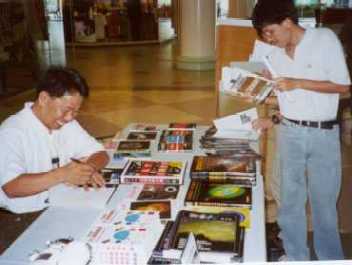
|
